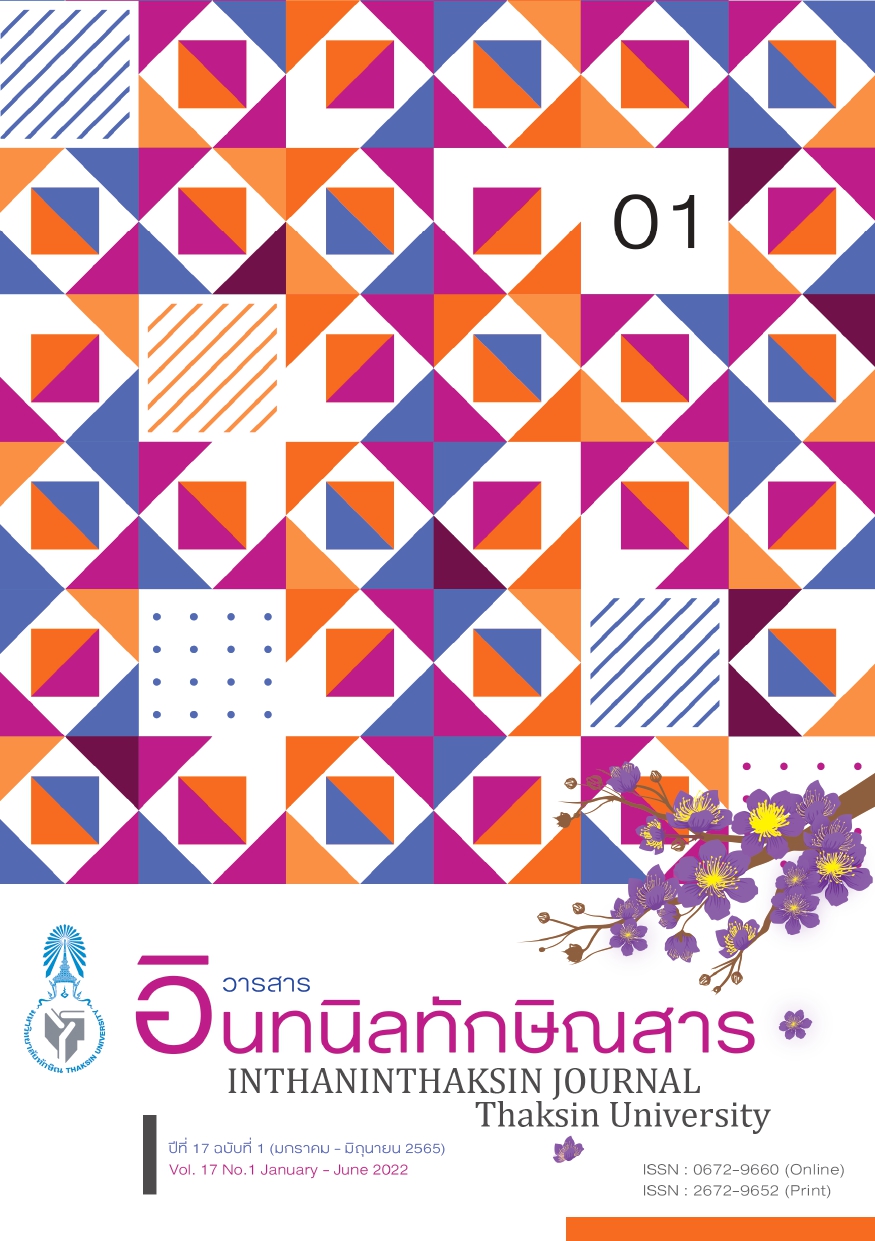ผลของการใช้กลยุทธ์ภาษาเป้าหมายต่อการพัฒนาทักษะภาษาอังกฤษของนักศึกษาระดับอุดมศึกษาในบริบทที่ใช้ภาษาอังกฤษเป็นภาษาต่างประเทศ
Main Article Content
บทคัดย่อ
วัตถุประสงค์ของงานวิจัยนี้ เพื่อเปรียบเทียบผลการใช้กลยุทธ์การสอนภาษาที่แตกต่างกันระหว่างกลยุทธ์การใช้ภาษาเป้าหมาย (อังกฤษ) และกลยุทธ์ภาษาที่ 1 ของผู้เรียน (ไทย) ในการสอน เพื่อพัฒนาทักษะภาษาอังกฤษของนักศึกษาระดับอุดมศึกษา และศึกษาปัจจัยที่ส่งผลต่อการเรียนรู้ของผู้เรียน เมื่อมีการใช้กลยุทธ์ภาษาเป้าหมายในชั้นเรียน กลุ่มตัวอย่าง ประกอบด้วย นักศึกษาชั้นปีที่ 4 จากมหาวิทยาลัยแห่งหนึ่งในจังหวัดยะลา จำนวน 40 คน แบ่งออกเป็น 2 กลุ่ม ได้แก่กลุ่มทดลอง และกลุ่มควบคุม กลุ่มละ 20 คน กลุ่มทดลองได้รับการสอนโดยการใช้กลยุทธ์ภาษาเป้าหมาย กลุ่มควบคุมได้รับการสอนโดยการใช้กลยุทธ์ภาษาที่ 1 ของผู้เรียน เครื่องมือวิจัยที่ใช้ได้แก่ แบบทดสอบก่อน และหลังเรียน และแบบสัมภาษณ์ กึ่งโครงสร้าง ข้อมูลวิจัยได้รับการวิเคราะห์ และอธิบายในรูปแบบบรรยาย ผลการศึกษา พบความแตกต่างอย่างมีนัยสำคัญทางสถิติที่ระดับ 0.01 ค่าเฉลี่ยของแบบทดสอบหลังเรียนของกลุ่มทดลอง (x̄=19.35, SD=3.11) สูงกว่ากลุ่มควบคุม (x̄=16.22, SD=1.73) และผลการวิเคราะห์ข้อมูลจากแบบสัมภาษณ์เกี่ยวกับปัจจัยที่ส่งผลต่อการเรียนรู้ของผู้เรียนพบว่า สื่อการเรียนการสอน กิจการรมการจัดการเรียน และวัจนและอวัจนภาษาของผู้สอน เป็นปัจจัยสำคัญที่ส่งเสริมการเรียนรู้ในการเรียน โดยการใช้กลยุทธ์ภาษาเป้าหมาย อย่างไรก็ตาม พบปัจจัยที่เป็นอุปสรรคเช่นเดียวกัน ได้แก่ ระยะเวลาที่ใช้ในการสอน สื่อเทคโนโลยี และความสามารถด้านภาษาอังกฤษของผู้เรียน ผลของการวิจัยสรุปได้ว่า การเรียนโดยการใช้กลยุทธ์ภาษาเป้าหมายสามารถพัฒนาทักษะภาษาอังกฤษของนักศึกษาในบริบทที่ใช้ภาษาอังกฤษเป็นภาษาต่างประเทศได้ โดยพิจารณาปัจจัยต่าง ๆ ที่เกี่ยวข้องอย่างรอบคอบ
Article Details

อนุญาตภายใต้เงื่อนไข Creative Commons Attribution-NonCommercial-NoDerivatives 4.0 International License.
เอกสารอ้างอิง
Al-Nofaie, H. (2010). The Attitudes of Teachers and Students Towards Using Arabic in EFL Classrooms in Saudi Public Schools-A Case Study, Research on Youth and Language. 4 (1) 64-95.
Anton, M., & Dicamilla, F. J. (1999). Socio-Cognitive Functions of L1 Collaborative Interaction in the L2 Classroom, The Modern Language Journal. 99, 233-247.
Bambaeeroo, F., & Shokrpour, N. (2017). The Impact of the Teachers’ Non-Verbal Communication on Success in Teaching, Journal of Advances in Medical Education & Professionalism. 5, 51-59.
Carson, E., & Kashihara, H. (2012). Using the L1 in the L2 classroom: The students speak. The Language Teacher. 36 (4), 41-48.
Choomthong, D. (2014). Preparing Thai students’ English for the ASEAN Economic Community: Some pedagogical implications and trends, Language Education and Acquisition Research Network (LEARN) Journal. 7 (1), 45-57.
Cook, V. (2001). Using the first language in the classroom, The Canadian Modern Language Review. 57 (3), 402-423.
Dearden, J. (2014). English as a medium of instruction–a growing global phenomenon: Phase 1. London: British Council.
Gaebler, P. (2014). L1 use in FL classrooms: Graduate students’ and professors’ perceptions of English use in foreign language courses, CATESOL Journal. 25 (1), 66-94.
Gailea, N., Syafrizal, S., & Indasari I. (2018). Materials Selection in Teaching English Skills for Teacher of Senior Hight school in Serang City, Journal of English Language Teaching and Cultura; Studies. 1 (2), 90-102.
Gardner, R. C. (1985). Social psychology and second language learning: The role of attitudes and motivation. London: Edward Arnold.
Geringer, J. (2003). Reflections on professional development: Toward high-quality teaching and learning, Phi Delta Kappan. 84 (5), 373.
Jack, C. R., & Ricard, S. (2002). Longman Dictionary of Language Teaching and Applied Linguistics, (Third Edition). London: Longman.
Krashen, S. (1982) Newmark's "Ignorance Hypothesis" and current second language acquisition theory. Unpublished manuscript.
Littlewood, W., & Yu, B. (2009). First Language and Target Language in the foreign Language Classroom, Language Teaching. 42, 1-14.
Macaro, E. (2001). Analysing Students Teachers’ Codeswitching in Foreign Language Classrooms: Theories and Decision Making, The Modern Language Journal. 85, 531-548.
Macdonald, C. (1993). Using the target language. London: Mary Glasgow.
Mahmoudi, L., & Amirkhiz, S. (2011). The use of Persian in the EFL classroom:–The case of English teaching and learning at pre-university level in Iran, English Language Teaching. 4 (1), 135-140.
McGrath, I. (2013). Teaching Materials and the Roles of EFL/ESL Teachers. London: Bloomsbury.
Office of the Basic Education Commission. (2008). Basic education core curriculum B.E. 2551 (A.D. 2008). Bangkok: Ministry of Education.
Owoeye, J. S., & Yara, P. O. (2011) School Facilities and Academic Achievement of Secondary School Agricultural Science in Ekiti State, Nigeria, Asian Social Science. 7 (7), 64-74.
Phillipson, R. (1992). Linguistic imperialism. Oxford: Oxford University Press.
Polio, C. G., & Duff, P. A. (1994). Teachers' language use in university foreign language classrooms: A qualitative analysis of English and target language alternation, The Modern Language Journal. 78 (3), 313-326.
Sanglir, S., & Modehiran, P. (2017). Effects of English Speaking Instruction using stories on Speaking Ability and Participation of Thai EFL Second Grade Students in International Schools in Thailand, An Online Journal of Education. 12 (3), 111-127.
Tieocharoen, W., & Rimkeeratikul, S. (2019) Learning Strategies and Teaching Methods in Thai and Vietnamese Universities, Arab World English Journal (AWEJ). 11 (3) 99-112.
Tomlinson, B. (2012). Materials Development for Language Learning and Teaching. Language Teaching. 45, 143-179.
Turnbull, M., & Arnett, K. (2002). Teachers’ uses of the target and first languages in second and foreign language classrooms, Annual review of applied linguistics. 22, 204-218.
Vygotsky, L. (1986). Thought and Language. Cambridge, MS: The Massachusetts Institute of Technology.
Wiriyachitra, A. (2002). English language teaching and learning in Thailand in this Decade, Thai TESOL Focus. 15 (1), 4-9.


